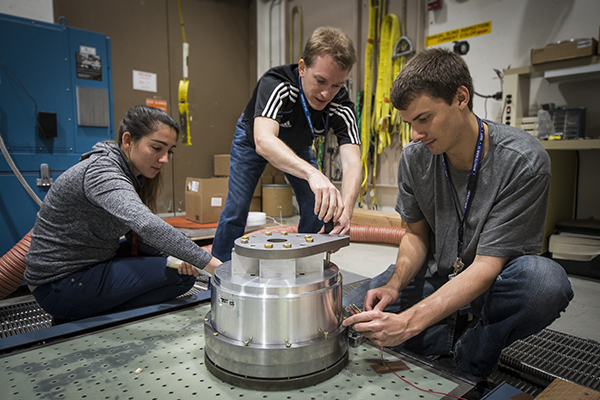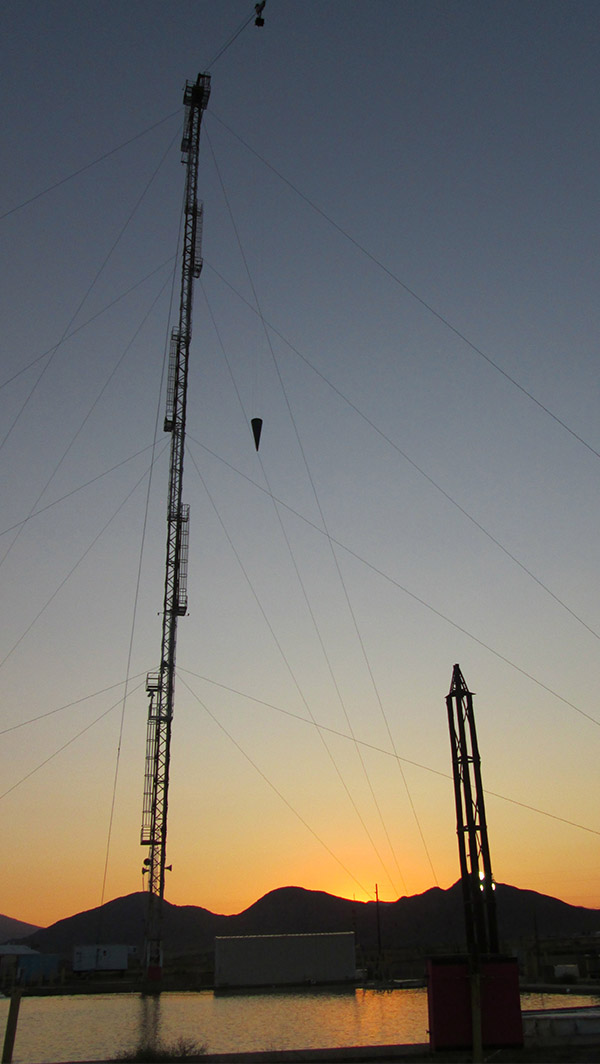Div. 8000 in forefront of cutting-edge weapons work
W80-4 LEP, Mk21 Fuze Replacement modernization programs on-time, on-budget
The W80-4 Life Extension Program (LEP) and the Mk21 Fuze Replacement program, both led in Div. 8000, have a shared commitment to on-time and on-budget delivery in support of Sandia’s nuclear weapons mission and in accordance with customer requirements.
Center 8200 Director Mike Hardwick says both programs are on track to achieve these goals, meeting all scheduled milestones to date, enabling the nuclear deterrent to function, and improving the safety, security, and reliability of the nation’s nuclear weapons stockpile.
“The California-based weapon modernization programs represent a significant investment of financial and staff resources,” Mike says. “We work closely with our New Mexico colleagues, our partners across the nuclear weapons enterprise, and our customers to ensure successful planning and execution.”
The W80-4 LEP and Mk21 Fuze replacement program are two of four major modernization programs being carried out at Sandia, with the other two being the B61-12 LEP and W88 ALT 370. Together, these efforts represent the largest nuclear weapon development investment at Sandia in decades.
W80-4 LEP
The W80-4 LEP is a high-impact program that is expected at its peak to employ up to 500 workers at Sandia. Over the 10-year period from initiation to First Production Unit, which is slated for 2025, the program will follow the 6.X process as established by DOE and DoD.

In July 2015 the program was approved to enter the feasibility study phase, Phase 6.2, which involved tremendous growth in terms of staff, partnerships, and design development.
Paul Spence (8420), acting senior manager overseeing W80-4 Weapon System Engineering organizations, says the W80-4 team counts among its accomplishments the establishment of three system engineering departments — two in California and one in New Mexico, the initiation of 23 product realization teams, implementation of risk review and engineering review boards, and progression of requirements and qualification planning.
“As we begin transitioning to the design definition and cost analysis portion of the program, Phase 6.2A, our team is focused on preparing for the WDCR — the Weapon Design and Cost Report — which is a key deliverable due in the third quarter of FY18,” says Paul.
The W80-4 team is supporting the WDCR process with a major scheduling and cost analysis initiative. Additionally, the team is preparing for full Earned Value Management System (EVMS) implementation much sooner than other development programs have in the past. EVM is a highly structured work assessment process that tracks work completed and budget spent against a plan, and is on track to be launched in late FY18.
EVMS implementation is one of the new requirements imposed on current weapon modernization programs by NNSA, the W80-4 program’s key customer. NNSA has also established new requirements for Nuclear Enterprise Assurance (NEA) designed to ensure resilience to adversarial subversion of the warhead design and supply chain.
The goal of the W80-4 program is to refurbish the W80-1 warhead, which involves replacing aging components to extend its life. Sandia is responsible for the development of non-nuclear components and subsystems, while Lawrence Livermore National Laboratory is responsible for the nuclear explosive package. Together, the two laboratories share the overall design responsibility for the warhead and have established a close partnership.
The W80-4 warhead is being integrated with the Long Range Stand-Off Missile (LRSO). NNSA is responsible for the W80-4 development program and the US Air Force is responsible for the LRSO development program. These programs are being conducted in parallel, with the development and qualification activities between NNSA and DOD carefully coordinated.
The Air Force intends to select two independent missile contractors to work on separate designs. With selection now imminent, the W80-4 team is preparing to support development of the two designs over the program’s 4.5-year Technology Maturation and Risk Reduction (TMRR) phase.
Paul attributes the accomplishments of the program to date to the committed group of talented staff and the strong partnerships developed with the many contributing organizations across the Labs, as well as the program’s production agency partners.
“We have brought together a diverse team of scientists, engineers, and programmatic staff to meet the challenges of this complex program,” Paul says.
MK21 Fuze replacement
Sandia’s on-going work on the Mk21 Fuze Replacement program continues to be an instrumental activity for the Laboratories. The fuze is an Arming and Fuzing Assembly (AFA) that assembles into the Mk21 reentry vehicle and interfaces with the W87 warhead. The reentry vehicle is deployed on the US Air Force Minuteman III intercontinental ballistic missile (ICBM).

This Air Force program is built on Sandia’s decades of experience in providing arming, fuzing, and firing systems for US Navy submarine-launched ballistic missile warheads. The Mk21AFA arms and triggers the warhead at a pre-determined point in flight.
Curt Nilsen (8250), senior manager of the Mk21 Fuze and Science Enabled Engineering group, says Sandia is responsible for designing the components of the Mk21 replacement fuze that must survive against adversarial defenses and a variety of other challenging environments.
“Sandia team members working on the Mk21 Fuze Replacement program continue to focus on product requirements and qualification activities,” says Curt.
“Qualification activities are key in demonstrating component and system performance to ensure program success.”
Sandia has been working on the Mk21 Fuze Replacement program since 2011 and has met all scheduled deliverables to the Air Force, Curt says. The program has conducted numerous environmental tests and is preparing for a flight test next year. Curt says the program is on track to meet the goal of creating the first production unit in 2022, with production expected to continue until 2029.
Sandia’s longstanding and productive working relationship with the Navy was a strong factor in the Air Force selection of Sandia to design the replacement Mk21 fuzes, Curt says. Contracting with Sandia also created the opportunity to gain efficiencies by leveraging commonalities between the Air Force and Navy fuzes through the W88 ALT 370 program. The program follows the NNSA Phase 6.X NW development process instead of the Defense Acquisition Process (DoD 5000 process) historically used by the Air Force.
“The Air Force has been pleased that Sandia has met all deliverables and has been complementary of the successes we have made to date,” says Curt. “The Air Force recognizes that Sandia is able to save taxpayers’ dollars by leveraging our work with the Navy. In addition, significant costs are avoided by not having to create separate production facilities and associated assessments.”
The Mk21 Fuze program is led by Science Enabled Engineering Org. 8250 and relies heavily on team members from across Sandia, especially in Divisions 2000 and 5000. The program has also used modeling and simulation tools developed by the Advanced Simulation and Computing program.
“I am pleased with teaming across Sandia and it’s encouraging to work with a group of people who are committed to meet the needs of the Air Force and the nation,” Curt says. “The success of the Mk21 Fuze Program is attributed to the commitment from a wide spectrum of individuals from throughout Sandia.”